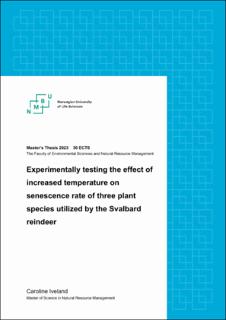| dc.contributor.advisor | Leif Egil Loe | |
| dc.contributor.advisor | Samantha Dwinnell | |
| dc.contributor.advisor | René van der Wal | |
| dc.contributor.author | Iveland, Caroline | |
| dc.date.accessioned | 2023-07-06T16:29:24Z | |
| dc.date.available | 2023-07-06T16:29:24Z | |
| dc.date.issued | 2023 | |
| dc.identifier | no.nmbu:wiseflow:6839581:54592351 | |
| dc.identifier.uri | https://hdl.handle.net/11250/3076832 | |
| dc.description.abstract | The Arctic is experiencing the most rapid climate warming on earth. While the climate induced changes in spring have received a lot of attention, similar studies for the effects in autumn have been neglected. In this thesis I experimentally investigate the effects that elevated temperatures and moisture levels in summer may have on the senescence rate of three of the most common foraging plants of the Svalbard reindeer. Open top chambers and heating ovens were used to manipulate the temperature and additional water was given to manipulate the soil moisture. I found that increased temperatures had a positive effect on all three species, while moisture only influenced Salix polaris. Onset of senescence was delayed for Alopecurus ovatus and Bistorta vivipara, and the rate of senescence was slowed for S. polaris and B. vivipara. The prolonged autumn with a greater amount of plant biomass could counteract the negative effects of harsh winters on the body mass of the Svalbard reindeer, and result in population growth. Thus, the future of the Svalbard reindeer and its foraging plants may be brighter than previously expected. | |
| dc.description.abstract | | |
| dc.language | eng | |
| dc.publisher | Norwegian University of Life Sciences | |
| dc.title | Experimentally testing the effect of increased temperature on senescence rate of three plant species utilized by the Svalbard reindeer | |
| dc.type | Master thesis | |
